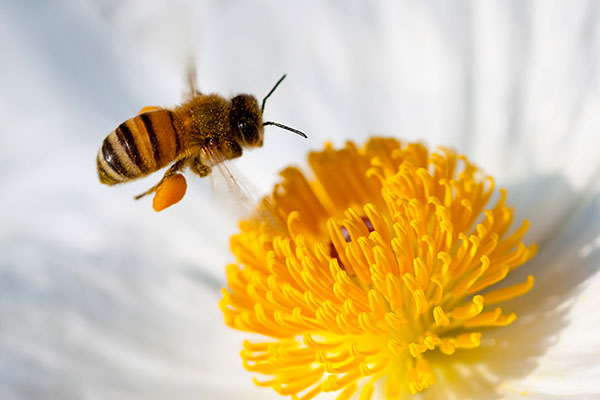
01 May In the spin cycle
It’s no surprise: pesticide corporations go to great lengths to protect the public image of their products. We’ve been highlighting their PR hijinks for years, and their attempts to spin facts to suit their agenda have only gotten more blatant.
Bees and pesticides provide the latest example. Corporate attempts to reframe the conversation, and subvert independent science, have gone into hyperdrive. Bayer, Syngenta and Monsanto in particular are positioning themselves as “bee friendly” — no matter that several top selling pesticide products are directly linked to bee deaths.
Highlighting the problem, our partners at Friends of the Earth just released a report — titled “Follow the Honey”— detailing a variety of ways “pesticide companies are spinning the bee crisis to protect profits.” The tactics outlined in the report aren’t new, but they’re alarming nonetheless.
Big problems
Numerous studies connect neonicotinoid pesticides (neonics) with harm to bees. This relatively new class of systemic insecticides can kill bees outright. At low levels, neonics can depress bee immune systems, inhibit their ability to navigate, and much more.
And when neonicotinoids are combined with other pesticides, this “chemical cocktail” compounds the bee-toxic qualities. Big problems for bees, particularly because neonics are the most widely used insecticides in the world.
While neonics and other pesticides aren’t the only challenge bees face — many factors are at play, including habitat loss, pathogens and nutrition — there is a direct link between these chemicals and dramatically declining bee populations. The science on this front is incredibly clear.
Big money
Given the size of the neonic market, Bayer, Syngenta and Monsanto all have a great deal at stake in protecting their products’ public image. Bayer and Syngenta, specifically, dominate global neonic manufacturing, primarily profiting from three top sellers. Their 2009 sales alone are impressive:
- Imidicloprid (Bayer): $1.1 billion
- Thiamethoxam (Syngenta): $627 million
- Clothianidin (Bayer): $439 million
And while Monsanto doesn’t manufacture neonics like the other two corporations, it sells neonic-treated seeds — also big business. In the U.S., 94% of the corn planted is pre-treated with neonics, as is much of the soy.
Spin, spin, spin
When it comes to neonics (or DDT, or cigarettes), the first line of corporate defense is to deny all culpability — and divert attention to another culprit. In this instance, corporate players continue to highlight the “multiple factors” argument.
Because while scientists agree that there is no one single cause of bee declines, they also agree that pesticides are a key factor — a point industry is quick to gloss over as they aim a finger at beekeeper mismanagement, pathogens and (particularly) varroa mites.
As stated in the FOE report, Bayer’s leading spokesperson on bee health said: “It’s generally known that the varroa mite is the main enemy of the bee.” There’s even a giant sculpture of a varroa mite at Bayer’s “Bee Care” center in Germany!
And on its “Plight of the Bees” webpage, Syngenta “enumerates 11 causes of the bee crisis and Colony Collapse Disorder, with only passing mention of pesticides in the context of farmers ‘misusing them.'”
While deflecting responsibility on one hand, industry is also mounting a positive PR campaign to show how much these corporations truly care about healthy bees. Bayer’s “Bee Care Tour” has been making its way across the country, stopping at research universities before landing in Washington, DC just in time for Pollinator Protection Week in June.
Last year, Monsanto hosted a three-day “Bee Health Summit” in Missouri, announcing the formation of a Bee Advisory Council. The focus of the council’s recommendations? More research on controlling the varroa mite, of course.
Meanwhile, on Capitol Hill …
On the day after FOE released its “Follow the Honey” report, a Bayer representative was on Capitol Hill testifying at a House hearing on pollinator health. David Fischer — Director of Pollinator Safety for Bayer’s North American Bee Care Center — stated at the hearing that “for more than 26 years, Bayer has been committed to improving bee health.” Huh.
Those in attendance at the hearing reported that there was little discussion on the impacts of neonics, with industry successfully focusing the conversation on their favorite bee-kill scapegoat: varroa mites.
While undoubtedly a problem, these mites do not explain the consistently dramatic bee declines since 2006. As Jeff Pettis, Research Leader of USDA’s Bee Research Lab, testified:
“…even if the varroa mite problem were solved today, this would not by itself solve all of the problems facing honey bees and beekeepers.”
Still, Bayer and friends are not backing down from their attempt to exonerate pesticides. Meanwhile, neonics are still widely used. And bees are still dying in record numbers.
Take action» People across the country are stepping up to protect bees from pesticides, including members of Congress. So far, the “Saving America’s Pollinators Act” has 60 co-sponsors, with more to come! Reach out to your Representative today and urge them to support this bee-protective bill.
Originally posted on GroundTruth by Sara Knight, Communications Director for Pesticide Action Network.

